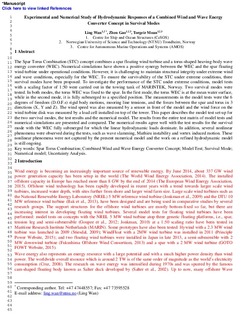| dc.contributor.author | Wan, Ling | |
| dc.contributor.author | Gao, Zhen | |
| dc.contributor.author | Moan, Torgeir | |
| dc.date.accessioned | 2017-12-04T13:19:13Z | |
| dc.date.available | 2017-12-04T13:19:13Z | |
| dc.date.created | 2015-12-04T13:32:55Z | |
| dc.date.issued | 2015 | |
| dc.identifier.citation | Coastal Engineering. 2015, 104 151-169. | nb_NO |
| dc.identifier.issn | 0378-3839 | |
| dc.identifier.uri | http://hdl.handle.net/11250/2469061 | |
| dc.description.abstract | The Spar Torus Combination (STC) concept consists of a spar floating wind turbine and a torus-shaped heaving-body wave energy converter (WEC). Numerical simulations have shown a positive synergy between the WEC and the spar floating wind turbine under operational conditions. However, it is challenging to maintain structural integrity under extreme wind and wave conditions, especially for the WEC. To ensure the survivability of the STC under extreme conditions, three survival modes have been proposed. To investigate the performance of the STC under extreme conditions, model tests with a scaling factor of 1:50 were carried out in the towing tank of MARINTEK, Norway. Two survival modes were tested. In both modes, the torus WEC was fixed to the spar. In the first mode, the torus WEC is at the mean water surface, while in the second mode, it is fully submerged to a specified position. The model tests recorded the 6 degrees of freedom (D.O.F.s) rigid body motions, mooring line tensions, and the forces between the spar and torus in 3 directions (X, Y and Z). The wind speed was also measured by a sensor in front of the model and the wind force on the wind turbine disk was measured by a load cell installed on top of the tower. This paper describes the model test setup for the two survival modes, and presents and compares the results from the tests and the numerical simulations. Several nonlinear phenomena were observed during the tests, such as wave slamming, Mathieu instability and vortex induced motion. The current numerical model based on linear potential theory cannot capture these nonlinear phenomena and requires a further development. | nb_NO |
| dc.language.iso | eng | nb_NO |
| dc.publisher | Elsevier | nb_NO |
| dc.rights | Attribution-NonCommercial-NoDerivatives 4.0 Internasjonal | * |
| dc.rights.uri | http://creativecommons.org/licenses/by-nc-nd/4.0/deed.no | * |
| dc.title | Experimental and numerical study of hydrodynamic responses of a combined wind and wave energy converter concept in survival modes | nb_NO |
| dc.type | Journal article | nb_NO |
| dc.type | Peer reviewed | nb_NO |
| dc.description.version | acceptedVersion | nb_NO |
| dc.source.pagenumber | 151-169 | nb_NO |
| dc.source.volume | 104 | nb_NO |
| dc.source.journal | Coastal Engineering | nb_NO |
| dc.identifier.doi | 10.1016/j.coastaleng.2015.07.001 | |
| dc.identifier.cristin | 1297055 | |
| dc.relation.project | Norges forskningsråd: 223254 | nb_NO |
| dc.description.localcode | © 2015. This is the authors’ accepted and refereed manuscript to the article. This manuscript version is made available under the CC-BY-NC-ND 4.0 license http://creativecommons.org/licenses/by-nc-nd/4.0/ | nb_NO |
| cristin.unitcode | 194,64,20,0 | |
| cristin.unitname | Institutt for marin teknikk | |
| cristin.ispublished | true | |
| cristin.fulltext | postprint | |
| cristin.qualitycode | 2 | |

